Color Decoration In Major Buildings
The ground-breaking decoration of the interior of the Exposition buildings was assigned to Adelaide J. Thorpe of New York City, who had worked with C.Y Turner, the Exposition's color designer. The buildings began as had all previous fair and exposition structures, a bare wooden frame covered on the outside with staff. At the Pan-American, Turner determined that visitors should experience a more finished interior atmosphere and that the interior colors should reflect the exterior colors and the building's purpose. In general, cheesecloth was dyed, treated to make it fireproof, sewn into lengths and then draped from the rafters. The walls were covered with burlap, also dyed. Bunting was used in some buildings, and flags and other insignia of the various countries was used "both to lend variety and gaiety to the general appearance of the buildings and to impart a note of patriotism and national pride in keeping with the general purpose of the great enterprise." [BEN 5/1/01]
U.S. Government Building
[exterior colors: walls, pale yellow; roof, blue]
The U.S. Government was responsible for interior decoration of its building complex. Flags were grouped about support pillars.
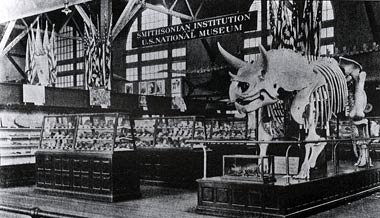
Machinery & Transportation Building
[exterior colors: walls, grayish green; roof, red tile]
The general color scheme is yellow with harmonious effects of green and red.
April 3: "This morning the workmen had the bunting, all festooned together, on the floor of the building. The clusters and festoons are hauled to the ceiling by ropes and fastened there. Then the strips are unfurled and the ends are tacked at the cornices. The effect was magical As the festoons unfurled, it was like the breaking bars of sunlight through the rifted clouds of a cold autumn day. Every noook and niche in the building were illuminated by the gorgeous colors, and in the space of two minutes the interior was transfored from the similitude of the hay loft to a gala hall."
"April 8: "The greater part of the ceiling is hidden by yellow and orange cheese cloth, illuminated in places by bursts of red, green, and orange-red. These clusters contain about 400 pounds of cloth each. It requires about 30,000 yards to cover the building."
Also installed were painted tapestries related to the exhibits that were to be displayed beneath.
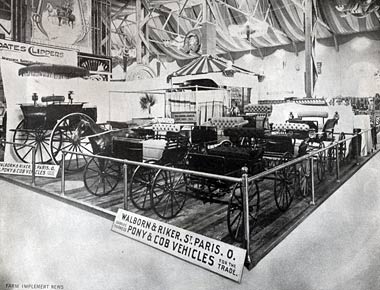
Electricity Building
[exterior colors: walls, grayish green; roof, red tile]
Violet and green were used in the building, green to symbolize electricity. "White material is relieved by violet and blue tints. The whole color scheme is light in effect. The great dome of this building, ablaze with arc lights, is treated with green bunting interspersed with starry festoons of light."
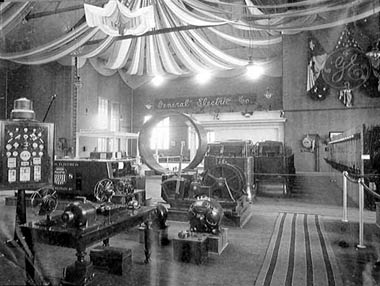
Manufactures & Liberal Arts Building
[exterior colors: light brown and reds; roof, light red tiles, blue domes at each corner and major entrance]
The interior was done in blue and gold draperies, the ceiling was done in blue.
200,000 yards of fabric were used in decorating the Manufactures and Machinery buildings alone.
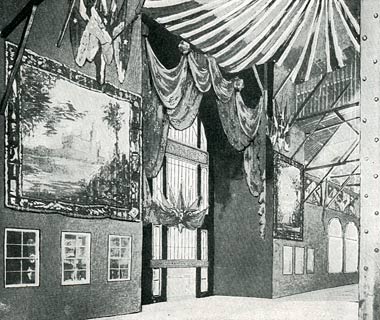
Horticulture Building
[exterior colors: walls, warm buff/orange with detailed doorways painted brilliantly to resemble majolica; roof, dark red tile]
The dome and columns were plastered, palms were placed as well as some statuary. Interior colors were green and white, to set off the fruits and flowers that were the primary exhibits.

Mines Building
[exterior colors: same coloration as the Horticulture building]
"Maroon-colored burlap on the walls, arches surmounted by allegorical panels in which considerable gold is used."
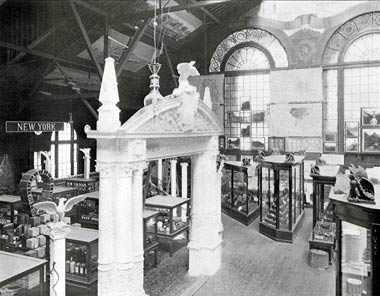
Graphics Building
[exterior colors: same as Horticulture building]
"Unlike the others, no flags are used. Walls are covered with olive green burlap, also used in connection of many different exhibits. As large number of book covers, photographs,etc. are exhibited in this room, the color has been kept a gray shade of green, so as to give a good background for the materials placed upon it. Over the arches and panels on the ceiling posters are used, and the whole effect is decidedly unique."

Agriculture Building
[exterior colors: light yellow, blue and ivory, with red and green at the entrances; roof light red tiles]
"Garlands extend around the room made of a combination of rye, oats, barley and the different kinds of corn. These are tied by strings of different colored poppies and hops, with here and there some of the brightest colored vegetables used in cartouches, adding bright tints to the grains."

The Woman's Home Companion (May,1901) described Miss Thorpe's work: "If you have never designed decorations for an exhibition you have no idea what it means. As there is no mural-painting, all these buildings must be made beautiful with drapery, flags and plants. Then there was just so much money to go on, and the amount and cost of every bit of bunting and burlap had to be figured out to the square yard. The decorators have charge of everything within twenty feet of the ground; below that the exhibitors supply their own decoration. The walls of the larger buildings are covered with burlap, and each building has a definite color scheme for the interior - a scheme arranged with regard to the exhibits. Thus the Electricity building is decorated in a light green, so as not to kill any of the light effectsd; Manufactures and Liberal Arts is blue and gold; the Machinery building has light and dark yellow; the Graphics Arts is olive-green; the Mines building red and yellow. From every building the visitor will carry away a definite impression of some one color. Besides the wall-hangings and the bunting a very large number of flags will be effectively used.
"The work necessary to bring all this to a consummation was not light. First, interior views of all buidings were submitted to Miss Thorpe, who made water-color drawings of her color schemes. She spent last summer in Europe, visiting not only the Paris Exposition, but many castles and palaces, and getting impressions rather than taking notes of decorative effects. Then she came home and worked out plans of her own.
"Her little box of an office at the Service building is an interesting place. The walls are covered with drawings, and there are samples of stuffs lying on the floor or draped over the doors and chairs. The practical part - the buying and hanging - requires nice skill and management, for she has a force of at least forty men working under her supervision."
By May 8, 1901, Miss Thorpe had 150 men working to decorate the buildings in order to finish by Dedication Day, May 20th.